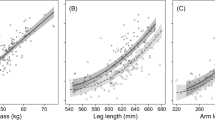Summary
The behavior of male bison during the rut was studied, to test the prediction that reproductive effort should increase with age. Because bull bison do not show parental care, the major component of reproductive effort is competition with other bulls to obtain copulations with estrous females. Data were collected on activity budgets during the pre-rut and rut seasons, on interactions with other bulls, and on proximity to tended females during the rut. Participation in the rut started at ages 5–6. Older bulls showed greater percent time active and less percent time eating than younger bulls. The older bulls also had higher counts of dominance and fight-related interactions and lower counts for behavior associated with submission than did the younger bulls. Risk taken seemed to increase with age since bulls aged 6 to 12 participated more frequently in dangerous activities associated with fighting. Within the 6 to 12 year old group, activity patterns changed little with age. However, from the interaction information, peak ages of 8 to 11 years appeared. For the activities: back up, chase, clash, head nod, jump away, move away, run away, run toward, push heads, dominant, and risk, 11 and 12 year olds more closely resembled younger bulls. This suggests a reproductive effort curve that is flat at zero until about age 6, increases to age 8, flattens out again to around age 10, and then decreases somewhat. Reproductive effort in male bison thus generally conforms with life-history theory predictions.
Similar content being viewed by others
References
Afton AD (1984) Influence of age and time on reproductive performance of female Lesser Scaup. Auk 101:255–265
Bergerud AT (1974) Rutting behaviour of Newfoundland caribou. In: Geist V, Walther FR (eds) The behaviour of ungulates and its relation to management. IUCN, Morges, pp 396–435
Byers JA, Kitchen DW (1987) Mating system shift in a pronghorn population. In review
Caswell H (1982) Optimal life history and the age-specific costs of reproduction. J Theor Biol 98:519–529
Clutton-Brock TH (1984) Reproductive effort and terminal investment in iteroparous animals. Am Nat 123:212–229
Clutton-Brock TH, Guinness FE, Albon SD (1982) Red deer: behavior and ecology of two sexes. The University of Chicago Press, Chicago
Emlen JM (1970) Age specificity and ecological theory. Ecology 51:588–601
Gadgil M (1982) Changes with age in the strategy of social behavior. In: Bateson PPG, Klopfer P (eds) Perspectives in ethology vol 5. Plenum Press, London, pp 489–501
Geist V (1971) Mountain sheep: a study in behavior and evolution. The University of Chicago Press, Chicago
Jarman MV (1979) Impala social behaviour: territory, hierarchy, mating, and the use of space. Z Tierpsychol Beih 21:1–92
Kitchen DW (1974) Social behavior and ecology of the pronghorn. Wildl Monogr 38:1–96
Lott D (1974) Sexual and aggressive behaviour of American bison (Bison bison). In: Geist V, Walther FR (eds) The behaviour of ungulates and its relation to management. IUCN, Morges, pp 382–393
Lott D (1979) Dominance relations and breeding rate in mature male American Bison. Z Tierpsychol 49:418–432
McHugh T (1958) Social behavior of the American buffalo (Bison bison bison). Zoologica 43:1–40
Pianka ER, Parker WS (1975) Age-specific reproductive tactics. Am Nat 109:453–464
Pugesek BH (1981) Increased reproductive effort with age in the California gull (Larus californicus). Science 212: 822–823
Robinson JG (1981) Spatial structure in foraging groups of wedge-capped capuchin monkeys (Cebus nigrivittatus). Anim Behav 29:1036–1056
Rubenstein DI (1982) Reproductive value and behavioral strategies: coming of age in monkeys and horses. In: Bateson PPG, Klopfer P (eds) Perspectives in ethology, vol 5, Plenum Press, London, pp 469–487
Ryan MR, Dinsmore JJ (1980) The behavioral ecology of breeding American coots in relation to age. Condor 82:320–327
Sinclair ARE (1974) The social organization of the East African buffalo (Syncerus caffer Sparrman). In: Geist V, Walther FR (eds) The behaviour of ungulates and tis relation to management. IUCN, Morges, pp 676–689
Struhsaker TT (1967) Behavior of elk (Cervus canadensis) during the rut. Z Tierpsychol 24:80–114
Williams GC (1966) Natural selection, the costs of reproduction, and a refinement of Lack's principle. Am Nat 100:687–690
Author information
Authors and Affiliations
Rights and permissions
About this article
Cite this article
Maher, C.R., Byers, J.A. Age-related changes in reproductive effort of male bison. Behav Ecol Sociobiol 21, 91–96 (1987). https://doi.org/10.1007/BF02395436
Received:
Accepted:
Issue Date:
DOI: https://doi.org/10.1007/BF02395436




